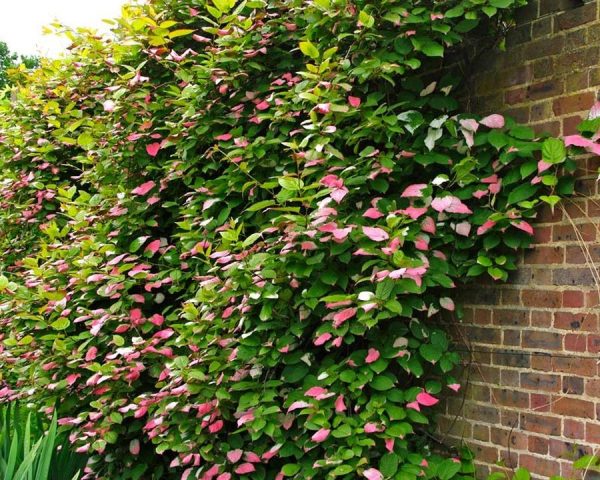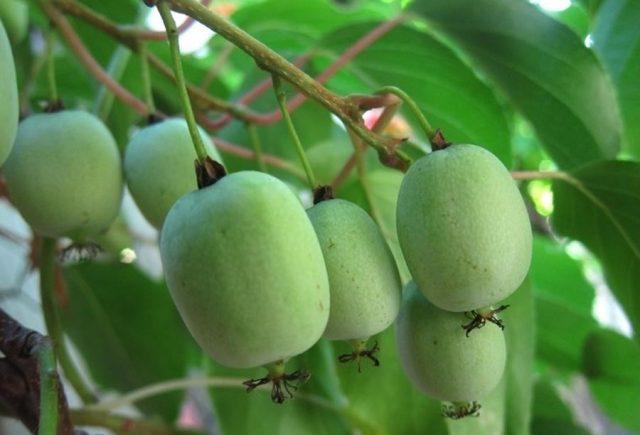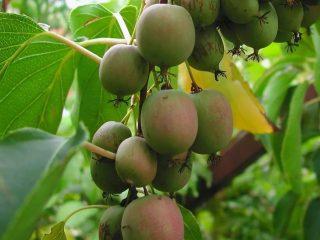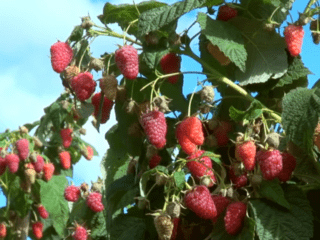Content
Actinidia kolomikta is an ornamental plant with edible, tasty fruits. Before planting a crop on a site, you need to study its basic requirements and reproduction characteristics.
Description of Actinidia kolomikta
Actinidia kolomikta, or creeper (Actinidia kolomikta) is a perennial vine of the Actinidiaceae family. It has long stems that spread along the surface or climb trees, sometimes it is an upright branched bush. The shoots of the plant are dark brown, smooth, shiny, and wrap around the support in a spiral.
The leaves of Actinidia kolomikta have a changing color - at the very beginning they are bronze, then they become green. Before flowering, the tips of the plates turn white, and after the buds wither, they acquire a pinkish or crimson color.In autumn, the leaves of the crop turn yellow or purple-red. The plates have an elliptical shape, their edges are serrated, and on the shoots they are arranged in a regular order on the petioles.
In mid-June, Actinidia kolomikta blooms with white or slightly pinkish buds with five petals. The decorative period lasts about 20 days, then the fruits ripen - dark green berries of an elongated or round shape. When ripe, they are soft and aromatic, with numerous dark brown or yellowish seeds. You can harvest from late August to mid-September; this should be done immediately after the fruits ripen. The berries do not stick well to the shoots and quickly fall off.

Actinidia kolomikta usually begins to bear fruit after 8-9 years of age.
You can find Actinidia kolomikta in its natural form in China, Japan, Korea, as well as on Sakhalin, Primorye, Amur region and in the south of the Khabarovsk Territory. The culture grows in mixed and coniferous forests, forming thickets in light areas and along the banks of small rivers. It can also develop in clearings, clearings and burnt areas.
Frost resistance of actinidia kolomikta
The cold resistance of the actinidia kolomikta shrub is quite high - up to -40 ° C with minimal shelter. The crop can be grown not only in the middle zone, but also in the northern regions, as well as in the Far East.
Productivity of actinidia kolomikta per bush
Actinidia kolomikta is a medium-yielding crop that can produce up to 800 g of berries from one bush. The volume of fruiting depends on the growing conditions and the quality of care.The crop exhibits maximum performance under favorable weather, regular watering and moderate fertilizing.
Height of Actinidia kolomikta
The plant has rather long shoots. If there is good support, the vines of Actinidia kolomikta climb to a height of up to 15 m above the ground.
The best varieties of actinidia kolomikta
Photos of actinidia kolomikta in the garden show that the plant is represented by a large number of varieties. Several varieties deserve special mention.
Waffle
Actinidia kolomikta has been listed in the State Register since 1999. Has good frost resistance. The leaves of the plant are olive, medium in size, the fruits are oval-elongated, up to 3.2 g in weight. The berries become greenish-brown in color after ripening. The pulp is tender and sweet, with a strong pleasant aroma.

Actinidia kolomikta waffle requires pollinators for fruit set
Queen of the Garden
The domestic Actinidia kolomikta is characterized by high immunity to diseases and pests. In the presence of pollinators nearby, it bears up to 800 g of fruits during the season. It is of medium height and ripens in late summer. The fruits of the variety are cylindrical, slightly flattened on the sides, uniformly olive-green in color. The berries taste sweet with a slight sourness and weigh 3.4 g.

The Queen of the Garden variety has a pronounced pineapple aroma
Large-fruited
The Actinidia kolomikta variety for the Leningrad region and Siberia produces moderately large berries up to 3.4 g. The shape of the fruit is regular, slightly elongated cylindrical, green in color. The pulp emits a faint kiwi aroma and has a sweet and sour taste. After ripening, the fruits stay on the branches for a long time and almost never fall off.

Actinidia kolomikta Large-fruited ripens from mid-August to early September
Gourmand
The mid-season variety of actinidia kolomikta has red-brown shoots and dark olive leaves. The berries are laterally compressed, cylindrical, with thin green skin. The fruits are sweet, with a pineapple smell. The variety is able to withstand cold temperatures down to -36°C.

The Lakomka variety bears large fruits weighing about 4.4 g
Folk
Actinidia kolomikta has been popular since 1998. It has high immunity to diseases, rarely suffers from pests, and ripens at the end of August. The berries are yellowish-green with a sweet and sour taste and aroma of strawberries.

Actinidia vernacular is self-sterile and requires pollinators for ovary formation
How to plant actinidia kolomikta
To plant actinidia kolomikta on a site, you need to choose a lighted or slightly shaded place with fertile and loose soil. It is best to place the crop in the southern, southwestern or southeastern part of the garden under the cover of a fence or facade, but at a distance of at least 0.8 m from it. The liana grows well on slightly acidic or neutral soil; it does not tolerate alkaline soils well.
Most varieties of the crop do not set fruit when planted alone. It is advisable to place Actinidia kolomikta in groups of 5-6 trees with at least one male plant in each.
Before planting, the selected area must be dug up. Pits up to 60 cm deep are prepared in the soil, and drainage made of broken brick or expanded clay is laid at the bottom. A substrate is poured on top, which is made from humus, peat, sand and ash, taken in a ratio of 1:6:4:1.Add 150 g of bone meal and 250 g of phosphorus-potassium fertilizer to each well.
After this, the pits are spilled with plenty of water and left for 2-3 days. Direct landing is carried out as follows:
- The seedlings are properly moistened.
- Lower the plants into the holes and spread the roots to the sides.
- Fill the voids with the remaining soil mixture.
- Water the plants generously again.
When planting, the root collars of seedlings are left flush with the ground. Plants are placed at a distance of 1.5-2 m so that they do not interfere with each other’s development.
How to care for actinidia kolomikta
The fruits of Actinidia kolomikta appear on the shoots in maximum quantities only with proper care. In order for a crop to produce abundant harvests, it is necessary to follow basic rules.
Pruning actinidia kolomikta
In order for the culture to remain attractive, it is necessary to prune Actinidia kolomikta in a timely manner. For plants on a flat trellis, a fan-shaped shaping pruning is usually used. Do it like this:
- In the first year after the buds wither, 3-4 developed vertical shoots are selected and laid in a fan on a trellis. Other stems are cut to the ground.
- After autumn leaf fall, the selected shoots are shortened, completely removing the green part.
- The following year, the most developed side stems are laid horizontally on the trellis. Other shoots are shortened and the vines are pinched.
- After another year, the resulting stems are tied along the fan-shaped sleeves formed in the first year.
- The following summer, new strong shoots are pinched and attached horizontally to the second level of the trellis from the bottom.
After the bush has formed, all that remains is to remove the root shoots annually. In addition, during flowering and after autumn leaf fall, sanitary haircuts are performed. Pruning actinidia kolomikta in the fall for beginners and experienced gardeners involves removing weak, frozen, dry and diseased shoots.

Pruning can be carried out in the spring, but taking into account the fact that the sap flow of the crop begins quite early
From the age of 8-10 years of life, a rejuvenating haircut begins for the culture. Every year, one of the main “sleeves” on the trellis is removed and replaced with a strong young shoot.
Watering and fertilizing
Actinidia kolomikta requires moderate moisture throughout the season. During periods of heavy rainfall, the crop does not need to be watered. However, during severe drought, you need to add 80 liters of water to the tree trunk twice a week, otherwise the vine will begin to shed its leaves.
The plant should be fed three times per season. In early spring, granular nitrogen is added to the soil, and potassium and phosphorus are added at the stage of fruit formation. In the fall, after harvesting, actinidia kolomikta is fertilized again with superphosphate and potassium salt to increase winter hardiness and endurance.
Diseases and pests
With proper care, Actinidia kolomikta rarely suffers from illnesses. But in unfavorable conditions it can be harmed by:
- powdery mildew - the leaves of the crop are covered with a dry whitish coating;
Spraying with colloidal sulfur helps against powdery mildew.
- ramularia - the fungus leaves dark spots on the plates of the plant, preventing flowering and fruiting;
For ramulariasis, the vine is treated with Bordeaux mixture 1%
- fruit rot - ripening berries darken and become moldy, the disease quickly spreads throughout the bush;
Rot is difficult to treat, the affected areas are removed, and the remaining plant is treated with copper preparations
- leaf beetle - a beetle appears on the plant blades in early summer and eats the vine.
For leaf beetles, the vine is treated with systemic insecticides Actellik, Iskra and Aktara
Cats can also damage actinidia kolomikta. In the roots and bark of the plant there is a substance similar in action to valerian. If there are domestic animals on the site, it is advisable to cover the base of the trunk with nets or wooden shields.
Reproduction of actinidia kolomikta
Actinidia kolomikta can be propagated on a site in several ways. The culture responds well to seed and vegetative cultivation:
- Cuttings. In mid- or late August, the annual shoot is cut into several pieces and briefly soaked in a growth stimulator. After this, the cuttings are planted in a loose nutrient substrate and germinated until root primordia appear. For the winter, the plants are placed in cold storage, and in the spring, after the soil has thawed, they are transferred to the ground.
- By layering. At the beginning of the season, one of the two-year-old shoots is removed from its support and placed in a shallow groove in the ground. The branch needs to be secured from straightening, sprinkled with loose soil and watered throughout the summer. After the buds produce vertical shoots, the latter will need to be tied to pegs and hilled high. It is recommended to separate the seedlings and move them to a permanent place after a year.
- Seeds. Actinidia kolomikta grains are placed in damp sand in January, and in February they are placed in the refrigerator for stratification for 3-4 weeks. After this, the seeds are washed and placed on a moistened cotton pad in a warm place.After the sprouts appear, the vine is sown on the surface of loose soil and kept in conditions of high humidity under a film until green shoots form. Seedlings must be grown on a sunny windowsill until autumn. At the end of the season, the young vine is usually buried in the garden along with the box and insulated with fallen leaves.
Vegetative methods allow you to propagate Actinidia kolomikta as quickly as possible and with full preservation of the characteristics of the mother bush. New varieties are usually grown from seeds. The culture sprouts quite easily, but begins to bloom no earlier than in the third year.
Photo of actinidia kolomikta in landscape design
Culture in design is most often used to decorate fences, blank facades without windows, arches and gazebos. Long vines attach securely to natural supports or trellises and help bring life to the landscape.

Actinidia kolomikta can be planted near windows, as when flowering it emits a pleasant citrus or banana aroma
Actinidia kolomikta can be used in artistic compositions. An overgrown vine can protect other plants from wind and bright sun, so it can be planted next to decorative flower beds.
Conclusion
Actinidia kolomikta is a fairly unpretentious plant with rapid development. The culture not only decorates the garden, but also brings tasty edible fruits.
Reviews from gardeners about actinidia kolomikta












